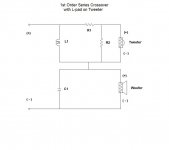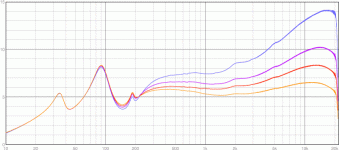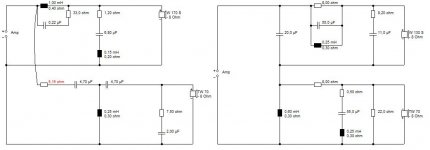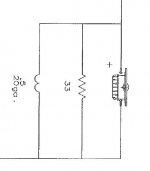That's quite alright. The penny will drop eventually...
http://www.diyaudio.com/forums/multi-way/206843-sreten-speakerman-go-series-xos-56.html#post3046046
I'd listen to wolf-teeth too. He has built these things.
http://www.diyaudio.com/forums/multi-way/206843-sreten-speakerman-go-series-xos-56.html#post3046046
I'd listen to wolf-teeth too. He has built these things.
My question is: will a parallel resistor on the tweeter alter the characteristics of a first-order series crossover?
If anyone has specific knowledge on the subject, I would appreciate your reply. If you have experience with series crossovers, I would be interested in hearing about that also. Thanks to all.
Attached is a sketch of the basic 1st order 2-way series, with an L-pad on the tweeter.
In the context of your question, there is no series resistor in the L-pad (R1), only the parallel resistor (R2).
A parallel resistor (R2) will tend to attenuate the tweeter. One point of caution is to make sure that the combined impedance doesn’t go too low.
I’ve found that there is a lower limit to the size of R2 where sound quality is affected, and of course it depends on the particular tweeter. I usually try not to use R2 by itself to attenuate more than 1 or 2 dB. In general, my preference is to use the series resistor (R1) as a more effective way to attenuate the tweeter. Sometimes using 30 to 50 ohms for R2 takes out just a little of the high frequency hash, if present. Removing too much can eliminate valuable details from the sound quality.
I use series crossovers most of the time, perhaps if for no other reason than for my own amusement.
Typically, I use 2nd order on the tweeter, where a capacitor is located in-line with R1. (One end is attached to the inductor L1). That gives a steeper roll-off, allowing for a crossover frequency that’s closer to the tweeter resonance.
Along with that, 1st order on the woofer is usually adequate. An impedance compensation (Zobel) on the woofer helps flatten the woofer’s impedance. This can help to make a smoother transition to the tweeter’s impedance.
Your thought of flattening the impedance of the tweeter could be accomplished with its own “Zobel”, but there’s really little benefit in doing so.
With the right combination of drivers and circuit components, a series crossover can yield a relatively flat impedance, which is sometimes desirable.
The down side of higher orders (or additional components in the network) is the complexity, and the difficulty for mere mortals to set up and perform calculations. Without a lot of trial and error, the best approach is to use some kind of simulation software.
Attachments
Last edited:
I like to use series 1st order when i can. It requires a well thot out design & drivers with with extension well beyond the XO. I also choose a more sensible XO point where i can keep the drivers within 1/4 wl.
Here is an actual impedance plot of a 2-way with 100uF + 5mH (nominal 8R tweeterm 4R woofer) reflecting the changes by adding a shunt R of 15, 25, and 15||25R.
Tweeter is in an aperiodic TL that does a good job of significantly reducing the tweeter impedance peak.
The above is still a work in progress.
dave
Here is an actual impedance plot of a 2-way with 100uF + 5mH (nominal 8R tweeterm 4R woofer) reflecting the changes by adding a shunt R of 15, 25, and 15||25R.
Tweeter is in an aperiodic TL that does a good job of significantly reducing the tweeter impedance peak.
The above is still a work in progress.
dave
Attachments
Sometimes using 30 to 50 ohms for R2 takes out just a little of the high frequency hash
Our listening bears this out. Levels are no attentuated much at all.
dave
I haven't been able to do any simming with smooth polycones for series crossovers, but it always seems to come down to drivers that play nicely together with a series XO work even better with a parallel crossover. 
Here's some paper drivers with a parallel and a series. I much prefer what I'm seeing with parallel in terms of impedance and cone-breakup suppression. As DaveR says, first order bass, second order tweeter is minimum in either topology. FWIW, the LCR Fs resonance filter in the second (series) example is effectively second order.
If I was going to try a simpler series filter, I'd really want something like that famous Vifa P13WH of Lynn Olson's, or a Morel driver. Around 0.6mH anyway, to avoid needing bafflestep correction.
Here's some paper drivers with a parallel and a series. I much prefer what I'm seeing with parallel in terms of impedance and cone-breakup suppression. As DaveR says, first order bass, second order tweeter is minimum in either topology. FWIW, the LCR Fs resonance filter in the second (series) example is effectively second order.
If I was going to try a simpler series filter, I'd really want something like that famous Vifa P13WH of Lynn Olson's, or a Morel driver. Around 0.6mH anyway, to avoid needing bafflestep correction.
Attachments
Tvrgeek, that looks like an interesting project, but if I may make some suggestions: before you make a passive filter, first do some measurements and listening tests with an active setup using something like a MiniDSP. This will show you which filter slopes and xover frequencies will work best. Don't just measure on axis, but also look at what happens off the horizontal and vertical axis. 5K from mid to tweeter is in my experience way too high, as you will note from such tests.
A very nice little speaker that would match up good with your other components is the Fountek FR88EX they have at Madisound. It is advertised as fullrange, which it is. It does have some breakup above 10KHz and ultrasonic it goes nuts, but it is a very good midrange.
Actually, I do my first tests with my DCX. And surprise! I was looking at the FE88 or 89. The 89 seems to have a slightly better motor.
The listening position for where these will go is pretty much on axis. Even a 3 inch , yea maybe that is high. 4K then? Remember, the low slope means the tweeter is still doing a lot lower down. Only testing will tell. The purpose if this build is to see if getting the crossovers out of the critical sensitive hearing range and low order crossovers is the next step. Some claim it to be so. If it fails, I just upgrade the FE85's on my computer and rebuild the Seas into another set like I have. Only building and letting my wife listen will tell.
For those who have not followed all my amp escapades, she has the most fantastic and critical hearing of anyone I know. The slightest problem in the mids is a "no". My last Seas set were my first "yes" speakers and could be tolerated on a wideband amp. ( Parasound). I found I had to use Rotels to tame whatever every other speaker was doing. They are clever in their compensation design that makes them highly suitable for less than perfect speakers, where the good Mr. Curl does not tolerate weak speakers so he designs amps expecting perfection. Two designs both perfectly suited to their market. I now have a pile of RB 951's for sale.
I like to use series 1st order when i can. It requires a well thot out design & drivers with with extension well beyond the XO. I also choose a more sensible XO point where i can keep the drivers within 1/4 wl.
Here is an actual impedance plot of a 2-way with 100uF + 5mH (nominal 8R tweeter 4R woofer) reflecting the changes by adding a shunt R of 15, 25, and 15||25R.
Tweeter is in an aperiodic TL that does a good job of significantly reducing the tweeter impedance peak.
The above is still a work in progress.
dave
If the primary goal was to manage the impedance, why not a Zobel? More expensive, but does a better job. Unless you are crossing the tweeter over to a super tweeter, the increasing impedance may be a good thing as conventional solid state amps generate less distortion with a higher impedance load. 16 Ohms is Nirvana for most. If you are transformer output, then the rules change completely, so for the fans of glass bottles, ignore why I have not seen the need for taming tweeter Le where you may consider it paramount.
Did Dave say he was working on a multi-way? Hark! Oh I forget. A full range, with a sub and a helper super tweeter in the same cabinet looks just like the big old floorstanders
Wolf,
I doubt the tweeters Fs was the issue. Welcome to the club of us who found this is to an easy driver to use well; but if so, very good indeed. The trick is keeping the the XT25 above 3K. It just plain won't stop flopping in the breeze below that. Look at it's CSD plot. Second order electrical at 4K makes it much happier.
You see I built those Xenums with the SC50 (previous version of SC90) back in 2008. I also had the same issue with the XT25TG30 in my Scandivifias in late 2007, as both are non-FF and have a high Zmax at Fs to compensate. 4th at 3k won't need a notch or comp on the TG30. In both cases, suppressing the Fs magnitude at least a little gets rid of the buzzing issue.
Later,
Wolf
Hmmm. Just used ARTA to measure the response of an XT-25 with and without a 10 Ohm shunt resistor. Solid state amp. Other than the tiny difference in amplitude, the MLS plot 1/24 octave un-smoothed is identical. By identical. printed and held to the light. Identical within the width of the plot line.
Last edited:
If you had no series component, the FR will not change, only the impedance will reflect a difference. There has to be a voltage divider.
Are you doing a full-sweep? The Fs is where the problem would be heard.
Quick-Check: Play James Taylor stuff on it in a system, with and without comp.
Later,
Wolf
Are you doing a full-sweep? The Fs is where the problem would be heard.
Quick-Check: Play James Taylor stuff on it in a system, with and without comp.
Later,
Wolf
Wolf,
Actually my questions were for the OP (post # 7), but I appreciate your explanation of when a resistor in parallel with a tweeter is useful.
From all of the discussion so far, it's obvious the OP, if he expects to get help, has to be specific rather than general about 1st order series crossover networks and a resistor in parallel with the tweeter. The tweeter he intends to use should be named and what his proposed cross-over frequency is.
Regards,
Pete
Actually my questions were for the OP (post # 7), but I appreciate your explanation of when a resistor in parallel with a tweeter is useful.
From all of the discussion so far, it's obvious the OP, if he expects to get help, has to be specific rather than general about 1st order series crossover networks and a resistor in parallel with the tweeter. The tweeter he intends to use should be named and what his proposed cross-over frequency is.
Regards,
Pete
Sweet Baby James? Any tips on track or what to listen for? I usually rely on Joni Mitchel and Joan Baez as their voices seem to be really tough. Then Julian Bream's guitar, Harry James horn, Dave Grusin for "tightness" in the bass, etc.
I used the DCX for a fourth order at 1K for my test. This puppy needs to be used above 3K, so any problem in a sweep at 450 where the Fs is is just not going to tell me much. Right or wrong?
I used the DCX for a fourth order at 1K for my test. This puppy needs to be used above 3K, so any problem in a sweep at 450 where the Fs is is just not going to tell me much. Right or wrong?
TVR-
It mostly has to do with his lower range than the higher stuff. "On the Roof" is a good example. "Carolina in my Mind" would also likely work.
Since you knocked down the resonance issue for your test before the measurements were taken, you won't experience their issues. I xover'd at 2.6kHz, and was fine, BW3 acoustic- as long as the resistor (or LCR) was present. It does not have to be used above 3kHz only, but it gets easier if you do.
The increase towards Fs is rather gradual, and peaks really high, and is why it should be dealt with. The SC90/50 can take a 2.5kHz xover point, and the TG30 can take a 2.1-2.2kHz xover point.
Granted, I'm using passive filters for this, so YMMV...
Wolf
It mostly has to do with his lower range than the higher stuff. "On the Roof" is a good example. "Carolina in my Mind" would also likely work.
Since you knocked down the resonance issue for your test before the measurements were taken, you won't experience their issues. I xover'd at 2.6kHz, and was fine, BW3 acoustic- as long as the resistor (or LCR) was present. It does not have to be used above 3kHz only, but it gets easier if you do.
The increase towards Fs is rather gradual, and peaks really high, and is why it should be dealt with. The SC90/50 can take a 2.5kHz xover point, and the TG30 can take a 2.1-2.2kHz xover point.
Granted, I'm using passive filters for this, so YMMV...
Wolf
I guess the key term there is "easier." With that we would agree. I try to pick drivers to use in their easy zone. Spend more on a tweeter and less on notch filters is my preference. We are nit-picking a $35 tweeter after all.
Thinking back on the crossover topology and the use of a parallel resistor. I just can't see a technical reason putting a 33 Ohm resistor in parallel with 4 Ohm VC is going to do much of anything useful unless it has significant inductance. Ever measure some of those "Low L audio quality" resistors? I have to think about this some more as I only see negatives.
Thinking back on the crossover topology and the use of a parallel resistor. I just can't see a technical reason putting a 33 Ohm resistor in parallel with 4 Ohm VC is going to do much of anything useful unless it has significant inductance. Ever measure some of those "Low L audio quality" resistors? I have to think about this some more as I only see negatives.
Just remembered - there a 33ohm on the Vifa/SF project that I've been working on.
James Taylor...don't have that in CD, but can't wait to let TVR listen to a Chris Isaak CD; very nice, outstanding baritone.
And if you remember, that was not the MS recommended solution but "advice" in a crossover that had several other odd things that did not work.
- Status
- This old topic is closed. If you want to reopen this topic, contact a moderator using the "Report Post" button.
- Home
- Loudspeakers
- Multi-Way
- Help with first order series crossover?





